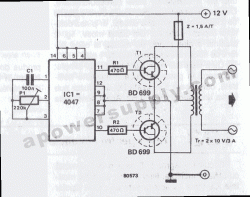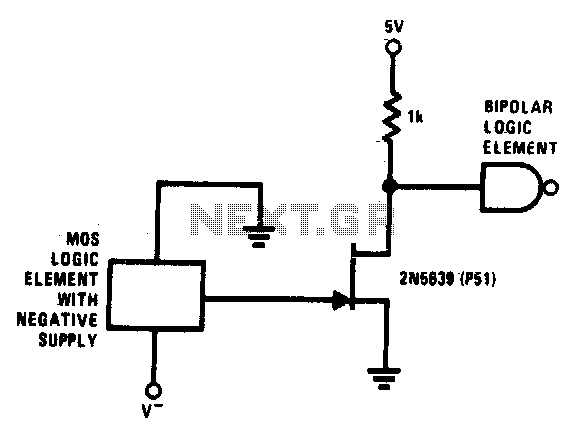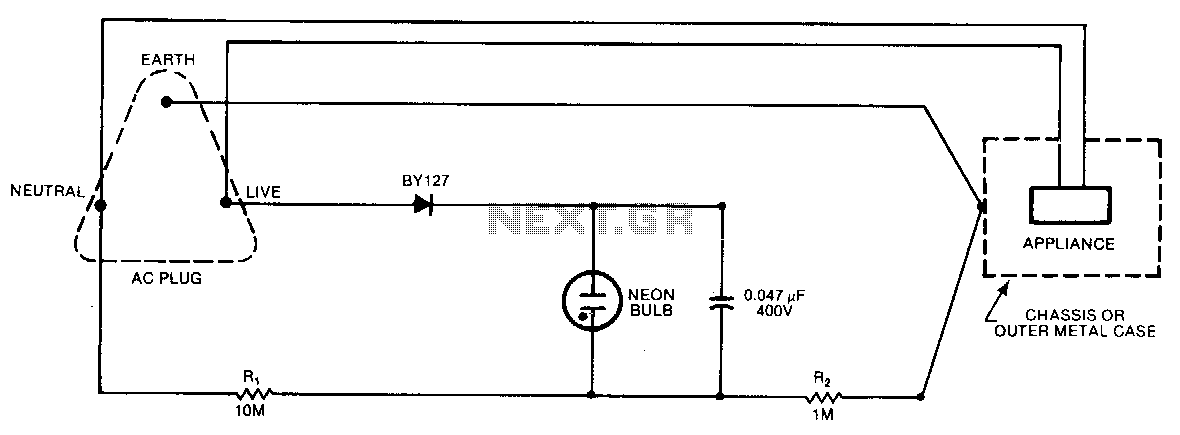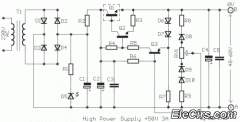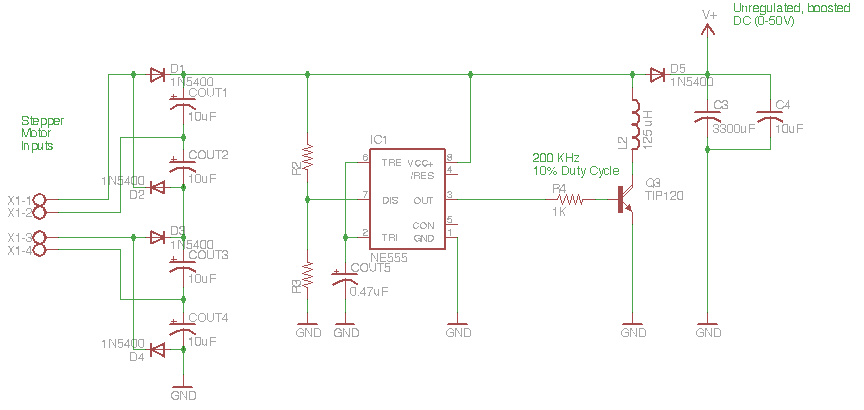
Soft Start For Switching Power Supply
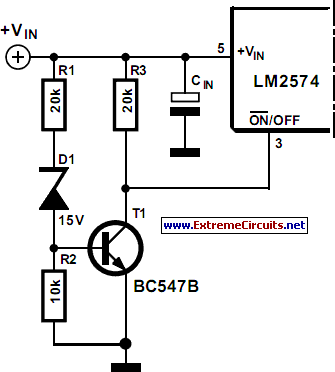
A switching power supply that has an output voltage significantly lower than its input voltage exhibits a unique characteristic: the current drawn from the supply is less than the output current. However, the input power (UI) is, naturally, greater than the output power. Another important consideration is that if the input voltage is too low at start-up, the regulator may attempt to draw the full current, which can lead to failure of the supply or blowing of the fuse. Therefore, it is advisable to disable the regulator during start-up (via the on/off input) until the associated capacitor is charged. Once the regulator begins to draw current, the charging current will have already decreased to a level that does not overload the voltage source. The circuit diagram provides an output voltage of 5 V, powered by a 24 V source. The regulator does not need to be disabled until the capacitor is fully charged; when the voltage across the capacitor reaches half or more of the input voltage, the system is stable. This is why the zener diode in the diagram is rated at 15 V. Many regulators manufactured by National Semiconductor feature an integrated on/off switch, which is utilized in this circuit. The input is designed for TTL signals and typically comprises a transistor with an externally accessible base. This configuration allows for a higher switching voltage to be applied through a series resistor, which is set to 22 k in this circuit. When the voltage across the capacitor reaches approximately 17 V, transistor T1 activates, enabling the regulator.
The switching power supply circuit functions by converting a higher input voltage (24 V) to a stable lower output voltage (5 V) while maintaining efficiency through controlled current draw. The process begins when the circuit is powered on; initially, the regulator is disabled to prevent excessive current draw that could damage the supply or blow fuses. The capacitor in the circuit plays a critical role in this process. It charges up to a sufficient voltage level, specifically around half of the input voltage (12 V), ensuring that when the regulator is enabled, it operates within safe limits.
The zener diode rated at 15 V serves as a voltage reference and protection mechanism in the circuit. It ensures that the voltage across the capacitor does not exceed its rated value, thus preventing damage to the components. When the voltage reaches approximately 17 V, transistor T1 is turned on, which in turn activates the regulator. This allows for the stable output voltage of 5 V to be supplied to the load.
The circuit design incorporates a TTL-compatible input for the on/off control, which is essential for interfacing with digital logic circuits. The use of a series resistor (22 k) with the base of the transistor allows for flexibility in switching voltage levels, accommodating various control signals without risking damage to the transistor. Overall, this design ensures reliable operation of the switching power supply while protecting against potential overcurrent situations during start-up.Switching power supply whose output voltage is appreciably lower than its input voltage has an interesting property: the current drawn by it is smaller than its output current. However, the input power (UI) is, of course, greater than the output power. There is another aspect that needs to be watched: when the input voltage at switch-on is too low , the regulator will tend to draw the full current. When the supply cannot cope with this, it fails or the fuse blows. It is, therefore, advisable to disable the regulator at switch-on (via the on/off input). until the relevant capacitor has been charged. When the regulator then starts to draw current, the charging current has already dropped to a level which does not overload the voltage source. The circuit in the diagram provides an output voltage of 5 V and is supplied by a 24 V source. The regulator need not be disabled until the capacitor is fully charged: when the potential across the capacitor has reached a level of half or more of the input voltage, all is well.
This is why the zener diode in the diagram is rated at 15 V. Many regulators produced by National Semiconductor have an integral on/off switch, and this is used in the present circuit. The input is intended for TTL signals, and usually consists of a transistor whose base is accessible externally.
This means that a higher switching voltage may be applied via a series resistor: the value of this in the present circuit is 22 k. When the voltage across the capacitor reaches a level of about 17 V, transistor T1 comes on, whereupon the regulator is enabled.
🔗 External reference
The switching power supply circuit functions by converting a higher input voltage (24 V) to a stable lower output voltage (5 V) while maintaining efficiency through controlled current draw. The process begins when the circuit is powered on; initially, the regulator is disabled to prevent excessive current draw that could damage the supply or blow fuses. The capacitor in the circuit plays a critical role in this process. It charges up to a sufficient voltage level, specifically around half of the input voltage (12 V), ensuring that when the regulator is enabled, it operates within safe limits.
The zener diode rated at 15 V serves as a voltage reference and protection mechanism in the circuit. It ensures that the voltage across the capacitor does not exceed its rated value, thus preventing damage to the components. When the voltage reaches approximately 17 V, transistor T1 is turned on, which in turn activates the regulator. This allows for the stable output voltage of 5 V to be supplied to the load.
The circuit design incorporates a TTL-compatible input for the on/off control, which is essential for interfacing with digital logic circuits. The use of a series resistor (22 k) with the base of the transistor allows for flexibility in switching voltage levels, accommodating various control signals without risking damage to the transistor. Overall, this design ensures reliable operation of the switching power supply while protecting against potential overcurrent situations during start-up.Switching power supply whose output voltage is appreciably lower than its input voltage has an interesting property: the current drawn by it is smaller than its output current. However, the input power (UI) is, of course, greater than the output power. There is another aspect that needs to be watched: when the input voltage at switch-on is too low , the regulator will tend to draw the full current. When the supply cannot cope with this, it fails or the fuse blows. It is, therefore, advisable to disable the regulator at switch-on (via the on/off input). until the relevant capacitor has been charged. When the regulator then starts to draw current, the charging current has already dropped to a level which does not overload the voltage source. The circuit in the diagram provides an output voltage of 5 V and is supplied by a 24 V source. The regulator need not be disabled until the capacitor is fully charged: when the potential across the capacitor has reached a level of half or more of the input voltage, all is well.
This is why the zener diode in the diagram is rated at 15 V. Many regulators produced by National Semiconductor have an integral on/off switch, and this is used in the present circuit. The input is intended for TTL signals, and usually consists of a transistor whose base is accessible externally.
This means that a higher switching voltage may be applied via a series resistor: the value of this in the present circuit is 22 k. When the voltage across the capacitor reaches a level of about 17 V, transistor T1 comes on, whereupon the regulator is enabled.
🔗 External reference
